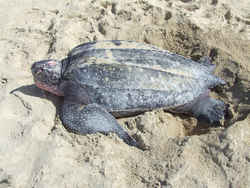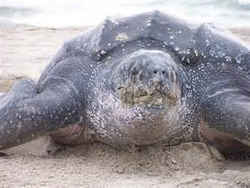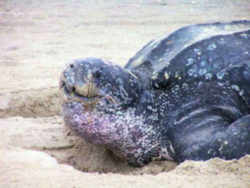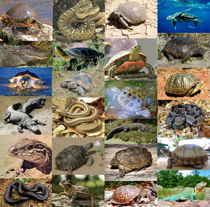
California Symbols
California State Marine Reptile
Leatherback Sea Turtle

Federally Endangered
(Dermochelys coriacea)
Adopted in 2012
The leatherback bill sponsored by SeaTurtles.org - AB 1776 - and authored by Assemblyman Paul Fong passed through the state Senate on unanimous bi-partisan votes.
Governor Jerry Brown signed the bill on September 26, 2012. Thank you Governor Brown for continuing California's legacy of ocean protection!
This historic legislation makes the endangered Pacific leatherback sea turtle the official marine reptile of California and declares October 15 as Pacific Leatherback Sea Turtle Conservation Day.
California State Marine Reptile:
Leatherback Sea Turtle

The Pacific leatherback sea turtle is the largest and deepest diving of all sea turtles. Adult leatherbacks can weigh up to 2000 pounds and can reach a length of 8 feet. Its species has been on the planet for 70 million years. The leatherback acquired its common name because its shell is made of small bones covered by a layer of rubbery skin. The turtle is black with white and pink spotting. The leatherback has been on the endangered species list since 1970.
Characteristics of California's Leatherback Sea Turtle

The leatherback sea turtle (Dermochelys coriacea), sometimes called the lute turtle, is the largest of all living turtles (as well as the largest extant sea turtle) and is the fourth largest modern reptile behind three crocodilians. It is the only living species in the genus Dermochelys. It can easily be differentiated from other modern sea turtles by its lack of a bony shell. Instead, its carapace is covered by skin and oily flesh. Dermochelys coriacea is the only extant member of the family Dermochelyidae.
- Weight: Adult: up to 2,000 pounds (900 kg)
Hatchling: 1.5-2 ounces (40-50 g) - Length: Adult: 6.5 feet (2 m)
Hatchling: 2-3 inches (50-75 cm) - Appearance:primarily black shell with pinkish-white coloring on their belly
- Lifespan: unknown
- Diet: soft-bodied animals, such as jellyfish and salps
- Behavior: females lay clutches of approximately 100 eggs several times during a nesting season, typically at 8-12 day intervals
California Legislation Assembly Bill No. 1776
AB-1776 State government: Pacific leatherback sea turtle.(2011-2012)
Assembly Bill No. 1776
CHAPTER 591
An act to amend Section 422.5 of, and to add Chapter 29.5 (commencing with Section 7593.5) to Division 7 of Title 1 of, the Government Code, relating
to state government.
[ Approved by Governor September 26, 2012. Filed with Secretary of State September 26, 2012. ]
LEGISLATIVE COUNSEL'S DIGEST
AB 1776, Fong. State government: Pacific leatherback sea turtle.
(1) Existing law establishes the state flag and the state's emblems, including, among other things, the poppy as the official state flower, the California
redwood as the official state tree, and the California desert tortoise as the official state reptile.
This bill would establish the Pacific leatherback sea turtle as the official state marine reptile.
(2) Existing law designates certain periods of time for specified purposes of celebration or recognition.
This bill would designate October 15, 2013, and every October 15 thereafter, as Pacific Leatherback Sea Turtle Conservation Day. The bill would encourage
public schools, state and federal agencies, nongovernmental agencies, fishers, coastal tour operators, and other interested stakeholders to engage
in certain activities, as specified.
Digest Key
Vote: MAJORITY Appropriation: NO Fiscal Committee: NO Local Program: NO
Bill Text
The people of the State of California do enact as follows:
SECTION 1.
The Legislature finds and declares all of the following:
(a) California is a coastal state that is dedicated to the protection of ocean resources, fisheries, and marine wildlife.
(b) Sea turtles, fish, seabirds, and marine mammals are a central component of California's natural heritage and marine biodiversity.
(c) The Legislature acknowledges that the Pacific leatherback sea turtle population has experienced a catastrophic decline over the past two decades
and might be on the verge of extinction.
(d) The Legislature further acknowledges that Pacific leatherback sea turtles are among the most imperiled of any sea turtle population in any ocean
basin on Earth and that populations of the Pacific leatherback sea turtle, a 100-million-year-old species that outlived the dinosaurs, have declined
by approximately 90 percent in the last 25 years.
(e) Pacific leatherback sea turtles foraging off the coast of California are part of a distinct Western Pacific breeding stock that nests on beaches
in Indonesia, Papua New Guinea, and the Solomon Islands.
(f) California's coastal waters are high-use foraging areas for summer nesters from this critically endangered population of Pacific leatherback sea
turtles, according to the National Marine Fisheries Service.
(g) Satellite tracking conducted over the past decade has determined that after nesting hundreds of individual Pacific leatherback sea turtles swim
more than 6,000 miles over 10 to 12 months to cross the Pacific to feed on jellyfish in California coastal waters every year.
(h) The Pacific leatherback sea turtles' trans-Pacific migration involved multiple years of migrating between California coastal waters during the
summer and lower latitude wintering areas without returning to Western Pacific nesting beaches.
(i) These movements and foraging strategies underscore the importance of and the need for ecosystem-based management and coordinated Pacificwide conservation
efforts.
(j) The Legislature supports efforts to recover and preserve the Pacific leatherback sea turtle population in oceanic feeding and migration areas,
which are identified as important strategies for their continued survival.
(k) On February 26, 2012, the National Marine Fisheries Service designated more than 16,000 square miles of California's coastal waters, and a total
of nearly 42,000 square miles along the United States West Coast, as critical habitat to protect high-use foraging areas and primary prey species for
the endangered Pacific leatherback sea turtle under the federal Endangered Species Act.
SEC. 2.
Section 422.5 of the Government Code is amended to read:
422.5.
(a) The California desert tortoise (Gopherus agassizii) is the official state reptile.
(b) The Pacific leatherback sea turtle (Dermochelys coriacea) is the official state marine reptile.
SEC. 3.
Chapter 29.5 (commencing with Section 7593.5) is added to Division 7 of Title 1 of the Government Code, to read:
CHAPTER 29.5. Pacific Leatherback Sea Turtle
7593.5.
(a) October 15, 2013, and every October 15 thereafter, is hereby designated as Pacific Leatherback Sea Turtle Conservation Day.
(b) The Legislature encourages California public schools to include Pacific leatherback sea turtles in their teaching lessons and curriculum whenever
possible.
(c) The Legislature encourages state and federal agencies, nongovernmental agencies, fishers, coastal tour operators, and other interested stakeholders
to establish and participate in a statewide, voluntary Pacific leatherback sea turtle watch to record sightings of the Pacific leatherback sea turtle
in California and West Coast waters.
(d) The Legislature encourages state and federal agencies to build cooperative relationships with the Western Pacific island nations where Pacific
leatherback sea turtles return to nest in order to increase awareness and conservation of this critically endangered species.
(e) The Legislature urges state and federal agencies to take proactive conservation measures and prevent further threats to Pacific leatherback sea
turtles and their habitats.
Taxonomic Hierarchy: Leatherback Sea Turtle
Kingdom: Animalia
Phylum: Chordata
Class: Reptilia
Order: Testudines
Family: Dermochelyidae
Genus: Dermochelys
Species: D. coriacea







